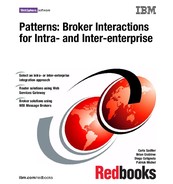Chapter 3. Application Integration pattern 65
Benefits
The Parallel Workflow application pattern improves the flexibility and
responsiveness of an organization by implementing end-to-end process flows
that externalize process logic from individual applications. Further flexibility is
introduced by the externalization of task-resource resolution rules.
It supports the reduction of cycle time by supporting parallel execution of portions
of a process flow.
In addition, it provides a foundation for automated support for Business Process
Management that enables monitoring and measurement of the effectiveness of
business processes.
Limitations
Only a few middleware products are capable of supporting all the capabilities
needed to realize this Application pattern. If this Application pattern is
implemented using middleware products that don’t support the necessary
capabilities, the implementation could be very complex.
Putting the Application pattern to use
ITSO Electronics, an electronics retailer/wholesaler, wants to integrate their retail
department with their two wholesale departments, namely Wholesale A and
Wholesale B. Currently, these three departments have proven IT infrastructures
but have no interconnectivity. ITSO Electronics wants to focus on automating the
inventory replenishment process.
The main difference from the scenario used in Parallel Process application
patterns sections is document here. In this scenario both Wholesalers are
queried in parallel to find who offers the shortest delivery time. The order is then
automatically placed with the wholesale department that offers the shortest
delivery date, unless the shortest delivery time received from the wholesale
departments exceeds 10 business days. In that case, a human intervention is
required by the Retail Department Manager to review the anticipated delivery
date to determine other sourcing options which must be considered.
To meet these business process automation requirements, ITSO Electronics
chooses the Parallel Workflow variation of the Parallel Process application
pattern. The primary drivers for this selection include the need for externalization
of process logic from individual application thus promoting flexibility and
responsiveness to changing business requirements, the need for reducing cycle
time of queries by simultaneously enquiring the two departments for the best
delivery date, and the need for supporting human interaction during the
execution of the process flow.
..................Content has been hidden....................
You can't read the all page of ebook, please click here login for view all page.
